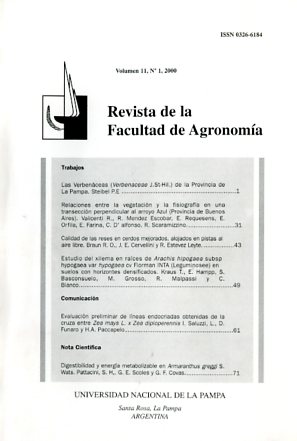Quality of the carcass in genetically improved pigs, lodged in outdoor finishing yards
Keywords:
Growing-finishing pigs, carcass quality, improved herdAbstract
Two groups of barrows of a genetically improved herd (A) and another one of a non improved (B), were controlled. The purpose of this work was to evaluate the carcass yield through the parameters: percentage (%) of lean tissue, backfat thickness and dressing percentage. Also, was to assess the association between the dressing percentage with the lean tissue percentage and backfat thickness in the improved groups. Barrows were fed from 50 kg live weight (l.W.) to slaughter 102 kg l.W., during 70 days into concrete housing in four groups of 3) pigs each. AII groups were fed ad-Iibitum with 14% crude protein (C.P.), 3.100 Kcal. digestible energy at kilogram (DElkg); 0.75% Ca; 0.50% P and 0.83% Iisine. The average results showed slgnlficant differences between treatments on measured parameters. Dressing percentage (p<0.05) A= 76,33 ± 3,00, B= 78,47 ± 3,32. Lean tissue percentage (p<0.01) A= 48,00 ± 2,61; B= 41,00 ± 2,41. Backfat results showed significant differences between treatments on measured parameters. Dressing percentage (p<0.05) A= 76,33 ± 3,60, B= 78,47 ± 3,32. Lean tissue percentage (p<0.01) A= 48,60 ± 2,61; B= 41,90 ± 2,41. Backfat thickness In mm (p<0.01) A= 15,89 ± 2,80; B= 23,76 ± 3,76. The simple lineal and quadratic regressions of the lean tissue percentage (r= 0.037 and r= 0.13) and backfal thickness lo the carcass yield were non significant (r= 0.105 and r= 0.106) respectively. 11 is important to emphasize the structural composition of the carcass of genetically improved herds. This gives the possibility to reach a belter price and also to improve the productive efficiency.
Downloads
References
CARDEN, A. 1995. Estación de Pruebes de Reproductores Porcinos. Convenio INTA - Mejoramiento Genético Porcino (MGP). Vol. 1 N° 1. Argentina.
CARDEN, A., P. GOENAGA y M. LLOVERAS. 19968 . Evaluación de sondas ópticas automáticas para predecir el contenido de magro en canales porcinas. Informe Técnico N° 144. EEA, INTA Pergamino. Argentina.
CARDEN, A., P. GOENAGA y M. LLOVERAS. 1996b . Informe Técnico N° 311. EEA, INTA Pergamino. Argentina.
DE CARO, A Y C. BASSO. 1997. Mercados y comercialización en Producción Porcina, estrategias para una actividad sustentable. Vieites, M. Ed. Hemisferio Sur, 506, p.
GOENAGA, P. 1995. Estación de Pruebas de Reproductores Porcinos. Convenio INTA - Mejoramiento Genético Porcino(MGP). 1 N°3.
Resolución N° 891.94. Diario Oficial. Secretaria de Agricultura, Ganadería y Pesca de la Nación. Argentina.
SOBESTIANSKY, J., Y. WENTZ, P. DA SILVEIRA y L. SESTI. 1998. Suinocultura intensiva. Brasil. EMBRAPA , 388 p.
VIEITES, M. 1997. Producción Porcina. Estrategias para una actividad sustentable. Ed. Hemisferio Sur, 506p.
WHITTEMORE, C. 1~. Ciencia Y Práctica de la Producción Porcina. Ed. Acribia, S.A., 647 p.
Downloads
Published
Issue
Section
License
La Editorial de la Universidad Nacional de La Pampa (EdUNLPam) exigirá a los/as autores/as la firma del siguiente documento:
La EdUNLPam lleva a cabo la publicación del artículo: (Título del Artículo) en SEMIÁRIDA Rev.Fac.Agron UNLPam ISSN 2362-4337 (impresa) ISSN 2408-4077 (en línea), del cual el/los abajo firmantes son autores de una o más partes. En el mismo acto, el/los autores entregan exclusivamente a la EdUNLPam todos sus derechos protegidos por las leyes de propiedad intelectual que rigen en la Argentina para reproducir, publicar, editar, fijar, comunicar y transmitir públicamente en cualquier formato o medio impreso o electrónico, inclusive internet, el artículo enviado a publicación e incluirlo en índices o bases de datos nacionales e internacionales. A cambio, la EdUNLPam entrega a los autores la autorización para la publicación o reimpresión con ines académicos y educativos en cualquier libro o medio de divulgación, con la sola obligación de citar el artículo original publicado en la EdUNLPam. Cada autor acuerda en que el material provisto a la EdUNLPam es un trabajo original, que no ha sido impreso o publicado en cualquier otro medio con anterioridad y que no vulnera derechos de terceros. El Primer autor tendrá la posibilidad de leer y corregir el artículo ya editado como “prueba de galera”, pero si el autor no devolviera esas correcciones de la prueba de galera dentro del tiempo especificado, el proceso de producción y publicación podrá proseguir sin la aprobación del autor. El/los autor/es no recibirán compensación monetaria de la EdUNLPam por el uso del material contenido en este artículo y asumen la responsabilidad de las opiniones vertidas en él.






.png)



22.png)



.jpg)




.jpg)
